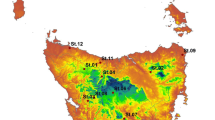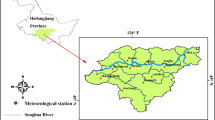Abstract
The agricultural production system and hydropower production of Pakistan is largely dependent on melting water from the Hindu Kush Himalayan and the Karakoram River basins. Regardless of such significant prominence, a complete evaluation of the prevailing state of hydro-climatic variables is missing. In this context, we examine the precipitation variability and uncertainty of river flows based on diversity indexes and Shannon information entropy theory. The results indicate that the Shannon diversity index presents a clear depiction of precipitation variability on all metrological stations as compared to the Simpson diversity index. The maximum precipitation variability was found at Chilas station as compared to Hunza, Bunji and Gilgit stations. The results also show that the diversity indexes are highly, negatively correlated with standard deviation, and the amount of precipitation is less than 50 mm (dry months). At the decadal scale, the Hunza and Astore stations show higher precipitation evenness as compared to the Skardu, Bunji and Gilgit stations. The uncertainty analysis shows higher entropy value E D = 90% for Indus River gauged at Mangla station. The higher entropy means the greater the chaos of the variables and the lower their certainty. The analysis exhibited that the rivers with high stream flow variability also show low entropy of its distribution and therefore higher stream flow concentration in the annual cycle.






Similar content being viewed by others
References
Allen R (2008) Quality assessment of weather data and micrometeological flux-impacts on evapotranspiration calculation. 農業気象 64:191–204
Archer DR (2003) Contrasting hydrological regimes in the upper Indus Basin. J Hydrol 274(1–4):198–210
Archer DR, Fowler HJ (2004) Spatial and temporal variations in precipitation in the Upper Indus Basin, global teleconnections and hydrological implications. Hydrol Earth Syst Sci Discuss 8:47–61
Archer DR, Fowler HJ (2008) Using meteorological data to forecast seasonal runoff on the River Jhelum. Pak J Hydrol 361:10–23
Arora M, Goel N, Singh P (2005) 57. Evaluation of temperature trends over India. Water Energy Abstr 15:21
Azmat M, Liaqat UW, Qamar MU, Awan UK (2017) Impacts of changing climate and snow cover on the flow regime of Jhelum River, Western Himalayas. Reg Environ Change 17:813–825. doi:10.1007/s10113-016-1072-6
Barberis C, Molnar P, Claps P, Burlando P (2003) Hydrologic similarity of river basins through regime stability Dipartimento Di Idraulica, Trasporti ed Infrastrutture Civili, Politecnico Di Torino
Bocchiola D, Diolaiuti G (2013) Recent (1980–2009) evidence of climate change in the upper Karakoram, Pakistan. Theor Appl Climatol 113:611–641
Böhner J, Lucarini V (2015) Prevailing climatic trends and runoff response from Hindukush- Karakoram-Himalaya, upper Indus basin. arXiv preprint arXiv:1503.06708
Bower D, Hannah DM, McGregor GR (2004) Techniques for assessing the climatic sensitivity of river flow regimes. Hydrol Process 18:2515–2543
Bronikowski AM, Altmann J (1996) Foraging in a variable environment: weather patterns and the behavioral ecology of baboons. Behav Ecol Sociobiol 39:11–25
Burn DH, Elnur MAH (2002) Detection of hydrologic trends and variability. J Hydrol 255:107–122
Chapman TG (1986) Entropy as a measure of hydrologic data uncertainty and model performance. J Hydrol 85:111–126
Chen X, Chen YD, Cy Xu (2007) A distributed monthly hydrological model for integrating spatial variations of basin topography and rainfall. Hydrol Process 21:242–252
Coe M, Cumming D, Phillipson J (1976) Biomass and production of large African herbivores in relation to rainfall and primary production. Oecologia 22:341–354
Dalezios NR, Tyraskis PA (1989) Maximum entropy spectra for regional precipitation analysis and forecasting. J Hydrol 109(1–2):25–42
Deshmukh I (1984) A common relationship between precipitation and grassland peak biomass for east and southern Africa. Afr J Ecol 22:181–186
Dunbar RI (1992) Time: a hidden constraint on the behavioural ecology of baboons. Behav Ecol Sociobiol 31:35–49
Kawachi T, Maruyama T, Singh VP (2001) Rainfall entropy for delineation of water resources zones in Japan. J Hydrol 246:36–44
Khattak MS, Babel MS, Sharif M (2011) Hydrometeorological trends in the upper Indus River Basin in Pakistan. Clim Res 46:103–119. doi:10.3354/cr00957
Koutsoyiannis D (2005) Uncertainty, entropy, scaling and hydrological stochastics. 1. Marginal distributional properties of hydrological processes and state scaling/Incertitude, entropie, effet d’échelle et propriétés stochastiques hydrologiques. 1. Propriétés distributionnelles marginales des processus hydrologiques et échelle d’état Hydrological Sciences Journal 50
Krasovskaia I (1995) Quantification of the stability of river flow regimes. Hydrol Sci J 40(5):587–598. doi:10.1080/02626669509491446
Krasovskaia I (1997) Entropy-based grouping of river flow regimes. J Hydrol 202(1–4):173–191. doi:10.1016/S0022-1694(97)00065-6
Kumar V, Jain SK, Singh Y (2010) Analysis of long-term rainfall trends in India. Hydrol Sci J Journal des Sciences Hydrologiques 55:484–496
Liu X, Xu Z, Yu R (2011) Trend of climate variability in China during the past decades. Clim Change 109:503–516. doi:10.1007/s10584-011-0097-6
Maruyama T, Kawachi T (1998) Evaluation of rainfall characteristics using entropy. 雨水資源化システム学会誌 4:7–10
Maruyama T, Kawachi T, Singh VP (2005) Entropy-based assessment and clustering of potential water resources availability. J Hydrol 309(1–4):104–113. doi:10.1016/j.jhydrol.2004.11.020
Miao C, Yang L, Liu B et al (2011) Streamflow changes and its influencing factors in the mainstream of the Songhua River basin, Northeast China over the past 50 years. Environ Earth Sci 63:489–499
Middelkoop H et al (2001) Impact of climate change on hydrological regimes and water resources management in the Rhine basin. Clim Change 49:105–128
Mukhopadhyay B, Khan A (2014) Rising river flows and glacial mass balance in central Karakoram. J Hydrol 513(26):192–203
Murphy PG (1975) Net primary productivity in tropical terrestrial ecosystems. In: Lieth H, Whittaker RH (eds) Primary productivity of the biosphere, vol 4. Ecological studies, Springer, New York, pp 217–231
Mu X, Li Y, Gao P et al (2012) The runoff declining process and water quality in Songhuajiang River catchment, China under global climatic change. CLEAN–Soil Air Water 40:394–401
Nalley D, Adamowski J, Khalil B (2012) Using discrete wavelet transforms to analyze trends in streamflow and precipitation in Quebec and Ontario (1954–2008). J Hydrol 475:204–228
Rasmussen R et al (2012) How well are we measuring snow: the NOAA/FAA/NCAR winter precipitation test bed. Bull Am Meteor Soc 93:811–829
Sen Roy S, Balling RC (2004) Trends in extreme daily precipitation indices in India. Int J Climatol 24:457–466
Sevruk B (1989) Precipitation Measurement. In: WMO/IAHS/ETH workshop on Precipitation Measurement, St. Moritz, 3–7 December 1989. Swiss Federal Institute of Technology
Shannon C (1948) A mathematical theory of communication. Bell Syst Tech J 27:379–423 (623–656 Mathematical Reviews (MathSciNet): MR10, 133e)
Singh V (1997) The use of entropy in hydrology and water resources. Hydrol Process 11:587–626
Smith MB, Koren VI, Zhang Z, Reed SM, Pan J-J, Moreda F (2004) Runoff response to spatial variability in precipitation: an analysis of observed data. J Hydrol 298:267–286
Sonuga JO (1972) Principle of maximum entropy in hydrologic frequency analysis. J Hydrol 17(3):177–191. doi:10.1016/0022-1694(72)90003-0
Tahir AA, Chevallier P, Arnaud Y, Ashraf M, Bhatti MT (2015) Snow cover trend and hydrological characteristics of the Astore River basin (Western Himalayas) and its comparison to the Hunza basin (Karakoram region). Sci Total Environ 505:748–761
Tahir AA, Adamowski JF, Chevallier P et al (2016) Comparative assessment of spatiotemporal snow cover changes and hydrological behavior of the Gilgit, Astore and Hunza River basins (Hindukush–Karakoram–Himalaya region, Pakistan). Meteorol Atmos Phys 128(6):793–811
Wrzesiński D (2010) Spatial differentiation of the stability of the flow regime of European rivers. Bogucki Wydawnictwo Naukowe, Poznań (in Polish)
Wrzesiński D (2013) Uncertainty of flow regime characteristics of rivers in europe. Quaest Geogr 32:43–53
Wrzesiński D (2016) Use of entropy in the assessment of uncertainty of river runoff regime in Poland. Acta Geophys 64:1825–1839
Wrzesiński D, Ptak M, Baczyńska A (2013) Effect of the North Atlantic Oscillation on ice phenomena on selected lakes in Poland over the years 1961–2010. Quaestiones Geographicae 32(3):119–128
Acknowledgements
This study is supported by the National Natural Science Foundation of China (nos. 51579044, 41071053, and 51479032), the Specialized Research Fund for Innovative Talents of Harbin (Excellent Academic Leader) (no. 2013RFXXJ001), and the Science and Technology Program of Water Conservancy of Heilongjiang Province (nos. 201319, 201501, and 201503).
Author information
Authors and Affiliations
Corresponding authors
Additional information
Responsible Editor: A.-P. Dimri.
Rights and permissions
About this article
Cite this article
Faiz, M.A., Liu, D., Fu, Q. et al. Assessment of precipitation variability and uncertainty of stream flow in the Hindu Kush Himalayan and Karakoram River basins of Pakistan. Meteorol Atmos Phys 131, 127–136 (2019). https://doi.org/10.1007/s00703-017-0553-6
Received:
Accepted:
Published:
Issue Date:
DOI: https://doi.org/10.1007/s00703-017-0553-6




